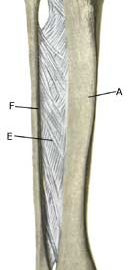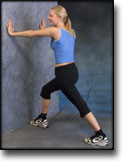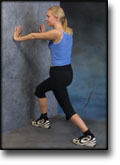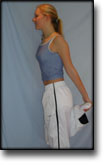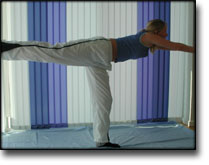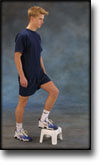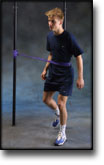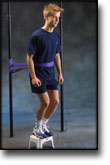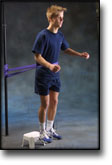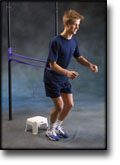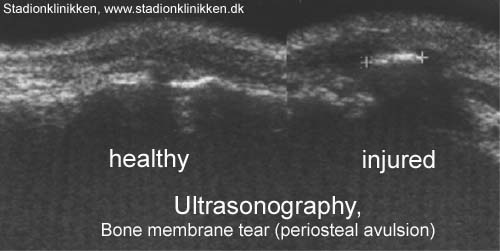|
Anatomy: The ankle joint is stabilised by a joint-capsule as well as a wide fan shaped ligament on the inside (ligamentum deltoideum/mediale), and a set of outer ligaments (ligamentum talofibulare anterius fore, ligamentum calcaneofibulare centre, and ligamentum talofibulare posterius at the rear). There is also a strengthening of the ligaments fore and rear (ligamentum tibiofibulare anterius & posterius). The joint-capsule and ligaments stabilise the ankle joint, especially when twisting and running with sudden directional changes.
Cause: A rupture of the joint-capsule at the front of the ankle joint arises if the foot is over-stretched (plantar flexion), resulting in the joint-capsule over-streching and rupturing. This is often seen when a football player kicks the ground, or strikes the ball on the toe when trying to kick with the instep. In slight cases the injury can be termed a strain or sprain, and in more serious instances as full or partial rupture or tear.
Symptoms: Pain in the ankle joint which is worsened when stretching the ankle joint.
Acute treatment: Click here.
Examination: Medical examination is not necessarily required for very minor cases (slight sprain) with only minimal swelling and no discomfort when walking. The extent of the swelling is, however, not always a mark of the degree of the injury. Medical examination is recommended with more extensive swelling or pain, in order to eliminate bone fracture, bone membrane tear (periosteal avulsion), outer ligament injury in the ankle joint, inner ligament injury in the ankle joint and rupture of the ligament between shin and calf bones (syndesmosis rupture) (article). A normal medical examination is usually sufficient in order to make the diagnosis. X-ray examination will confirm or exclude any suspicion of fracture. Small bone membrane tears (periosteal avulsions) will be best seen using ultrasound scanning.
Treatment: Treatment of uncomplicated joint-capsule ruptures will usually be conservative (rehabilitation).
Bandage: It is recommended to use tape in the course of rehabilitation when starting to run on an uneven surface, with sudden directional change, or kicking balls. Taping does, however, not have the same importance as with injuries to the outer or inner ligament in the ankle (tape-instruction).
Prevention: Seesaw exercise is important in the rehabilitation phase, as well as in a preventive capacity. As a preventive measure, seesaw exercises should be performed frequently throughout the rest of the active sporting career if ligament injuries in the ankle joint have previously been experienced. Begin by standing with both feet on the seesaw and use hands for support on the wall. Gradually let go of the support to finally train by standing on only one leg (article). Special bandages have in some studies been shown to reduce the risk of ligament injuries (article).
Complications: If there is not a steady improvement in the condition consideration must be given as to whether the diagnosis is correct, or if complications have arisen:
|

